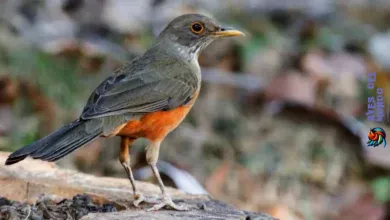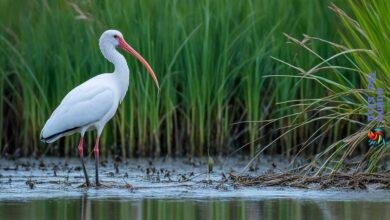Welcome to an exciting journey into the world of the Horned Screamer, a captivating bird species that has captured the attention of birdwatching enthusiasts and wildlife photographers alike. With its unique features and behaviors, the Horned Screamer offers a fascinating subject for those interested in exploring the wonders of nature up close and personal.
Known for its large, curved horn and distinctive calls, the Horned Screamer is a sight to behold. Whether you’re an avid birdwatcher or an aspiring wildlife photographer, encountering this majestic bird in its natural habitat is an experience unlike any other. With its striking appearance and intriguing behaviors, the Horned Screamer is sure to leave a lasting impression on anyone fortunate enough to witness it.
Key Takeaways:
- The Horned Screamer is an exotic bird species found in South America.
- Its unique features include a large, curved horn on its head.
- Birdwatching enthusiasts and wildlife photographers are attracted to the Horned Screamer for its distinctive appearance and behaviors.
- The bird is native to the wetlands of South America, particularly in countries like Brazil, Peru, and Venezuela.
- Its range extends from northern Argentina to Colombia, with the highest concentration of populations in the Amazon Basin.
Overview of the Horned Screamer
The Horned Screamer is a fascinating bird native to the wetlands of South America. Belonging to the Anhimidae family, which includes other species of screamers, this exotic bird species captivates birdwatchers and wildlife enthusiasts with its unique features and behavior.
- Long, slender body
- Large wings
- Distinctive horn on its head
With primarily gray plumage and white markings on its head and neck, the Horned Screamer stands out among South American birds. This herbivorous species feeds mainly on aquatic vegetation, making the wetland habitats its home.

Discovering the Horned Screamer
The Horned Screamer is native to South America, particularly found in countries like Brazil, Peru, and Venezuela. With its long, slender body, large wings, and distinctive horn, this bird is a unique sight to behold in the wetland habitats it calls home. Its gray plumage, along with white markings on its head and neck, adds to its remarkable appearance.
| Physical Characteristics | Habitat | Feeding Habits |
|---|---|---|
| Long, slender body | Wetlands of South America | Mainly feeds on aquatic vegetation |
| Large wings | ||
| Distinctive horn on its head |
Habitats and Range of the Horned Screamer
The Horned Screamer, one of the fascinating South American birds, can typically be found in freshwater wetlands such as swamps, marshes, and riversides. These wetland habitats provide ideal conditions for this bird species, offering both abundant aquatic vegetation for food and ample shelter.
The range of the Horned Screamer stretches from northern Argentina to Colombia, encompassing various countries in South America. However, the highest concentration of populations is found in the vast and biodiverse Amazon Basin. The wetlands of this region provide a haven for the Horned Screamer, ensuring it has suitable habitats to thrive in.
This unique bird is a resident species, meaning it does not embark on long-distance migrations. It is well-adapted to its wetland habitats and remains within its range for the most part of its life.
Horned Screamer Habitat Preferences
The Horned Screamer showcases a preference for wetland ecosystems teeming with aquatic vegetation. The combination of water bodies and an abundance of aquatic plants serves as an important ecological niche for this bird species.
These wetlands act as both a source of food and a secure shelter for the Horned Screamer. The aquatic vegetation provides the necessary sustenance, primarily comprising the bird’s herbivorous diet. In addition, the dense vegetation offers protection from predators and serves as nesting sites.
Range of the Horned Screamer
The Horned Screamer’s range extends throughout the countries of northern Argentina, Bolivia, Brazil, Colombia, Ecuador, Guyana, Paraguay, Peru, Suriname, and Venezuela. Within this range, the bird predominantly occupies wetlands and other suitable habitats associated with river systems.
To further visualize the distribution of the Horned Screamer, refer to the map below:

| Country | Range Area (km²) |
|---|---|
| Argentina | 60,000 |
| Bolivia | 25,000 |
| Brazil | 3,200,000 |
| Colombia | 100,000 |
| Ecuador | 5,000 |
| Guyana | 9,800 |
| Paraguay | 9,000 |
| Peru | 300,000 |
| Suriname | 1,100 |
| Venezuela | 40,000 |
Table: Horned Screamer Range by Country
The table above provides an overview of the Horned Screamer’s range area in different countries. It highlights the extensive presence of this remarkable bird across South America’s wetland ecosystems.
Behavior and Unique Traits of the Horned Screamer
The Horned Screamer is a remarkable bird known for its distinct behavior and unique traits. Let’s explore what sets this species apart in the avian world.
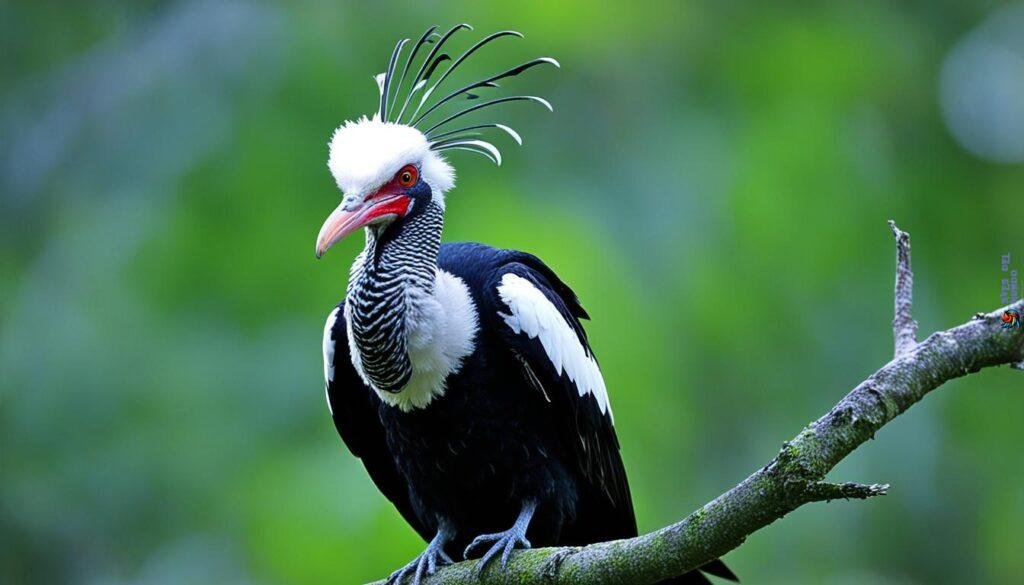
The Horned Screamer is famous for its loud vocalizations, resembling a series of screams or trumpeting calls. These vocalizations serve as a means of communication between individuals and play a vital role in defending their territory.
One of the most intriguing features of the Horned Screamer is the horn-like structure on top of its head. However, it’s important to note that this «horn» is not an actual horn at all. It is a hard and keratinized formation used for display purposes, which may also attract potential mates.
In addition to their vocalizations and «horn,» Horned Screamers are known for their elaborate courtship displays. During courtship, they engage in mesmerizing dances and impressive wing-flapping, captivating the attention of potential mates and demonstrating their vitality.
Fascinating Facts about the Horned Screamer:
- The Horned Screamer is one of the three species of screamers found in South America.
- The calls of the Horned Screamer can be heard up to two miles away.
- The horn-like structure on its head is made of keratin, similar to human hair and fingernails.
- Horned Screamers are excellent swimmers and can often be seen floating on the water or using their long legs to navigate through wetland habitats.
The behavior and unique traits of the Horned Screamer make it a captivating bird to observe and study. Its vocalizations, distinct head structure, and elaborate courtship displays contribute to the overall fascination surrounding this remarkable species.
Conservation Status of the Horned Screamer
The Horned Screamer, a fascinating bird species found in the wetlands of South America, is currently listed as a species of least concern by the International Union for Conservation of Nature (IUCN). However, despite its current status, habitat loss and degradation pose significant threats to its population.
Wetland drainage for agriculture and urban development has resulted in the loss of suitable habitats for the Horned Screamer. To ensure its long-term survival, conservation efforts are crucial.
Conservation initiatives focused on protecting the Horned Screamer include the establishment of protected areas and habitat restoration projects. These efforts aim to create safe spaces where the bird can thrive without disturbance and to restore and enhance wetlands, providing suitable habitats for the species.
One effective way to contribute to the conservation of the Horned Screamer is through bird watching tours. These tours not only allow enthusiasts to observe and appreciate the beauty of this unique bird but also play a vital role in raising awareness about its conservation needs and offering economic incentives for local communities to protect their natural habitats.
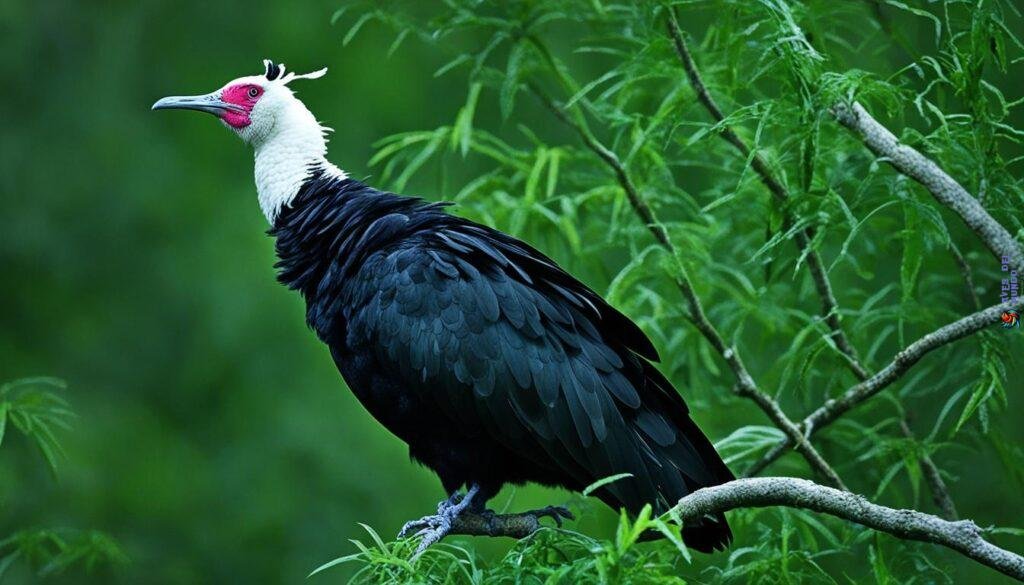
Conservation Efforts for the Horned Screamer
| Conservation Initiatives | Description |
|---|---|
| Protected Areas | Creation of protected areas where the Horned Screamer can thrive without disturbance. |
| Habitat Restoration | Projects aimed at restoring and enhancing wetlands to provide suitable habitats for the Horned Screamer. |
| Educational Programs | Initiatives designed to raise awareness about the importance of conservation and engage local communities in protecting the Horned Screamer and its habitats. |
Birdwatching and Photography Opportunities
The Horned Screamer is a sought-after species for birdwatchers and wildlife photographers. Its striking appearance and unique behaviors make it a fascinating subject to observe and capture in photographs.
Birdwatching tours in South America often include stops at known Horned Screamer habitats, providing bird enthusiasts with the opportunity to see and photograph these magnificent birds. Patience and a keen eye are required to spot them in their natural habitats, but the reward of witnessing their behaviors and capturing stunning images is well worth it.
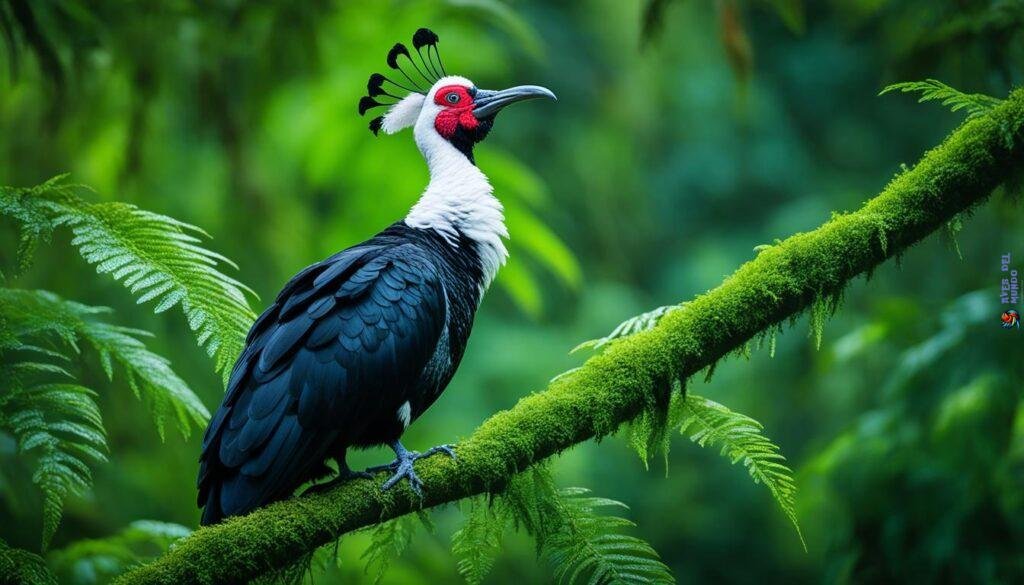
Birdwatching and photography enthusiasts can spend hours observing the Horned Screamer in its wetland habitat, carefully documenting its movements and interactions with other birds. The bird’s distinctive horn and elegant plumage make for captivating photographs, showcasing the unique beauty of this South American species.
Interesting Facts About the Horned Screamer
Discover some fascinating facts about the Horned Screamer, an exotic bird species that captivates bird enthusiasts and wildlife photographers:
- The Horned Screamer is one of the three species of screamers found in South America.
- Contrary to its name, the Horned Screamer does not actually scream. Instead, it produces loud trumpeting calls that can be heard from a distance.
- The «horn» on the bird’s head is not a true horn. It is made of keratin, the same material that makes up human hair and fingernails.
- Horned Screamers are highly skilled swimmers and are often seen gliding on the water or gracefully swimming with their long legs.
- They form monogamous pairs and are known for their lifelong mating commitment, symbolizing a strong bond between partners.
These intriguing characteristics make the Horned Screamer a truly remarkable and unique member of the avian world.
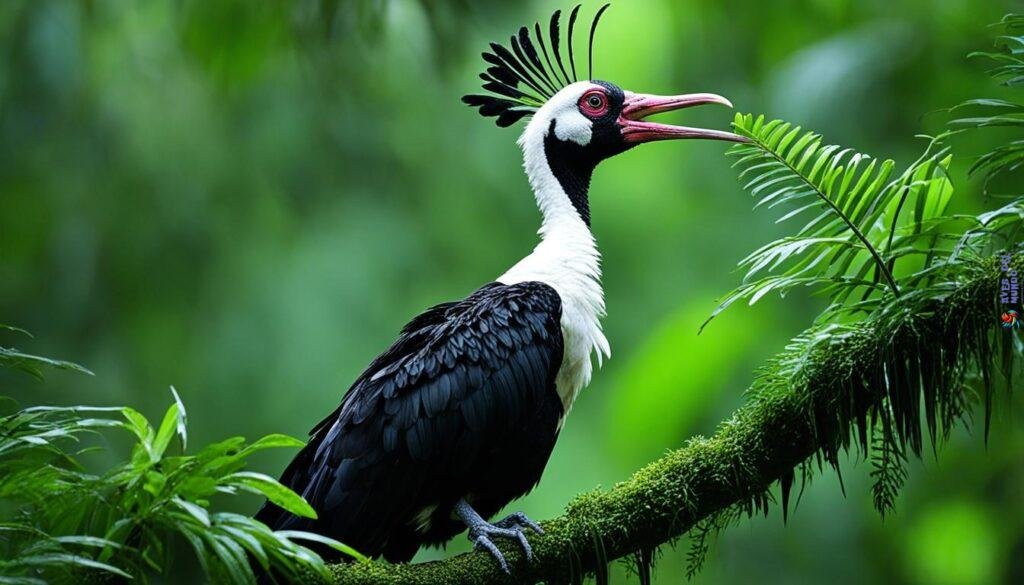
Conservation Efforts for the Horned Screamer
Conservation organizations and governments in South America are committed to protecting the Horned Screamer and its habitats. Various measures are being implemented to ensure the long-term survival of this unique bird species.
Creation of Protected Areas
One of the key strategies in safeguarding the Horned Screamer is the establishment of protected areas. These designated zones provide a haven where the bird can thrive undisturbed by human activities. Protected areas allow for the preservation of essential habitats and the ecosystems that support the Horned Screamer’s survival.
Habitat Restoration Projects
Habitat restoration plays a vital role in the conservation efforts for the Horned Screamer. Initiatives are underway to restore and enhance wetland habitats, aiming to recreate the ideal conditions that support the species. Restoration projects involve reestablishing aquatic vegetation and improving water quality, creating a suitable environment for the Horned Screamer to flourish.
Educational Programs and Community Involvement
Raising awareness about the importance of nature conservation and engaging local communities are critical aspects of protecting the Horned Screamer and its habitats. Educational programs and community involvement initiatives aim to foster a sense of stewardship among the population, promoting responsible actions that benefit both the bird and its environment.
«Protecting the Horned Screamer requires collaborative efforts from conservation organizations, governments, and local communities. By working together, we can ensure the preservation of this magnificent bird and the ecosystems it depends on.»
To visualize the conservation efforts for the Horned Screamer, refer to the table below:
| Conservation Measures | Description |
|---|---|
| Protected Areas | Designation of specific zones where the Horned Screamer is protected from disturbances, safeguarding its habitats. |
| Habitat Restoration | Efforts to restore wetland habitats and enhance their suitability for the Horned Screamer through the reintroduction of aquatic vegetation and water quality improvement. |
| Educational Programs | Initiatives aimed at raising awareness about the importance of conserving the Horned Screamer and engaging local communities in its protection. |
Through these conservation measures, dedicated individuals and organizations are striving to secure the future of the Horned Screamer, safeguarding its natural habitat and ensuring the long-term survival of this remarkable bird species.
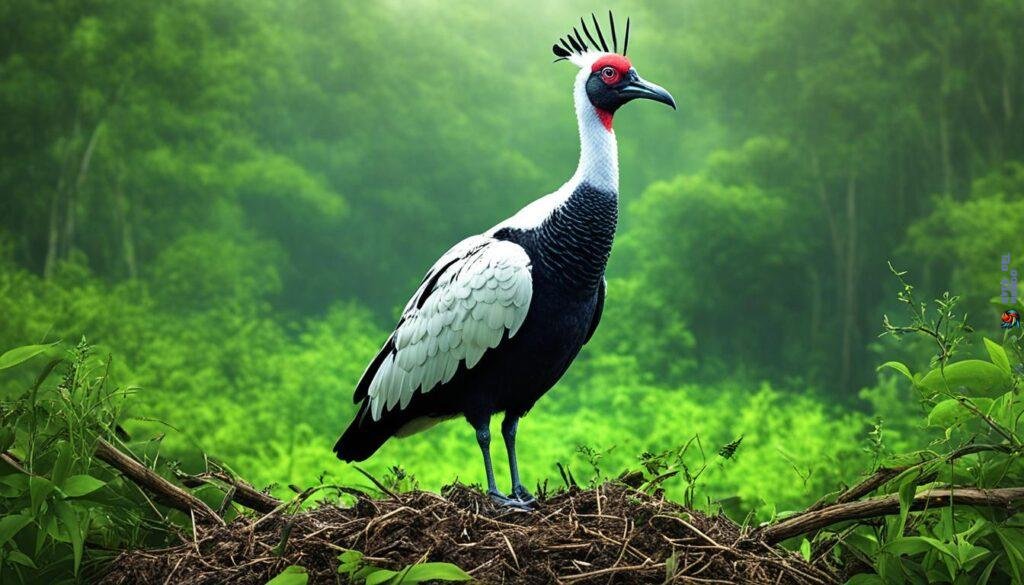
Conclusion
The Horned Screamer is a fascinating bird species native to the wetlands of South America. With its iconic horn and distinctive calls, it captivates the attention of birdwatching enthusiasts and wildlife photographers alike. However, the future of the Horned Screamer and its habitats depends on our commitment to nature conservation.
By supporting initiatives aimed at protecting the Horned Screamer and its fragile wetland ecosystems, we can ensure the continued existence of this remarkable South American bird. Conservation efforts, such as the establishment of protected areas and habitat restoration projects, play a crucial role in safeguarding the species and promoting biodiversity in the region.
Engaging in responsible birdwatching practices is also key to preserving the Horned Screamer. By respecting their natural habitats and observing them from a distance, we can minimize disturbance and contribute to their overall well-being. Through our collective efforts, we can inspire others to appreciate the beauty of South American birds and foster a culture of nature conservation for generations to come.
